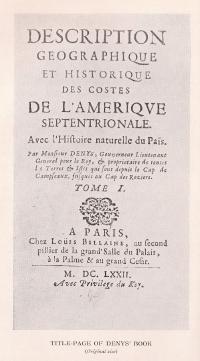Nicolas Denys
1598-1688
Nicolas Denys (settler, entrepreneur, author) was baptized 2 June 1603 in the parish of Saint-Saturnin, at Tours, France. In 1632 he was merchant at La Rochelle and agent and representative of the Compagnie de la Nouvelle-France. He was responsible for recruiting volunteers and fitting out the expedition being sent to Acadia under the command of Isaac de Razilly to take possession of the country under the terms of the Treaty of Saint-Germain-en-Laye and to endeavour to establish a colony there. The Razilly party arrived at La Hève (near the modern Bridgewater, N.S.) on 8 September 1632. Shortly afterwards, Denys started a fishing operation at Port Rossignol (now Liverpool). In 1635 Denys began cutting white oak in the form of planks and beams for export to France in vessels owned by Razilly, his partner in this first Canadian lumbering venture. Denys returned to La Rochelle, where he again acted as the representative of the Compagnie de la Nouvelle-France. About 1645 he obtained a concession from the company and built a fortified fishing and trading post on the south shore of Miscou Harbour. In 1647 d’Aulnay seized the Miscou post and expelled Denys. Upon receipt of the news of d’Aulnay’s death in 1650, Denys went to Cape Breton with his brother, Simon, for the purpose of fishing and trading. In 1652 Denys built another branch at Nipisiguit (Bathurst). During this visit to France, late in 1653 Denys purchased from the Compagnie de La Nouvelle-France for 15,000 livres the rights to the coast and islands of the Gulf of St. Lawrence from Cap Canso to Cap des Rosiers on the Gaspé. Shortly afterwards he was appointed governor and lieutenant-general of this territory. Denys now turned to organizing a fishing and trading company to operate within the limits of his grant. Once this latest business venture was launched, Denys returned to Saint-Pierre and restablished his fishing station and his trade with the indigenous people both there and at Nipisiguit. Saint-Pierre remained his headquarters, and there he fished, traded, did some farming, built several small vessels, and cut timber. About 1659 he built another fishing establishment at Chedabouctou (Guysborough). The following year his family moved to Chedabouctou. Because of fire, plunder, and war, Denys was in debt, and he was forced to move his family to the post he had built at Nipisiguit (now Bathurst, NB). In 1672 France, Denys succeeded in having two volumes published of Histoire naturelle des peuples, des animaux, des arbres & plantes de l’Amérique septentrionale, & de ses divers climats: avec une description exacte de la pesche des moluës, tant sur le Grand Banc qu’à la coste; & de tout ce qui s’y pratique de plus particulier. In 1687 the original grant to Nicolas Denys was revoked. Nicolas Denys died in 1688, probably at Nipisiguit.
Black, Britanny. "Nicholas Denys." New Brunswick Literary Encyclopedia, Winter 2008. Accessed 19 June 2024.
Archival Material
Two groups of papers relating to Nicolas Denys: the first of these, comprising 281 documents ranging in date from 1654 to 1860, the original papers preserved in Tours, France; the second group are the Fouquet papers in the Archives Départementales d’lle-et-Vilaine. These relate to Nicolas Denys himself and vary in date from 1654 to 1674 and comprise approximately 30 letters in the hand of Nicolas Denys. There is also the Agreement between N. and R. Denys of February 21, 1682, August 13, 1685 in the Judicial Archives of the District and of the City of Quebec (AJQ), (Genaple), Archives du Québec (AQ). Many of these papers are available at Library and Archives Canada on microform.

Title page of Description Geographique et Historique des costes de l'Amerique septentrionale by Nicolas Denys
"Nicholas Denys." New Brunswick Literary Encyclopedia, Winter 2008. Accessed 31 May 2023.

See the New Brunswick Literary Encyclopedia entry.